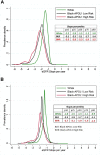Race, APOL1 Risk, and eGFR Decline in the General Population
- PMID: 26966015
- PMCID: PMC5004654
- DOI: 10.1681/ASN.2015070763
Race, APOL1 Risk, and eGFR Decline in the General Population
Abstract
The APOL1 high-risk genotype, present in approximately 13% of blacks in the United States, is a risk factor for kidney function decline in populations with CKD. It is unknown whether genetic screening is indicated in the general population. We evaluated the prognosis of APOL1 high-risk status in participants in the population-based Atherosclerosis Risk in Communities (ARIC) study, including associations with eGFR decline, variability in eGFR decline, and related adverse health events (AKI, ESRD, hypertension, diabetes, cardiovascular disease, pre-ESRD and total hospitalization rate, and mortality). Among 15,140 ARIC participants followed from 1987-1989 (baseline) to 2011-2013, 75.3% were white, 21.5% were black/APOL1 low-risk, and 3.2% were black/APOL1 high-risk. In a demographic-adjusted analysis, blacks had a higher risk for all assessed adverse health events; however, in analyses adjusted for comorbid conditions and socioeconomic status, blacks had a higher risk for hypertension, diabetes, and ESRD only. Among blacks, the APOL1 high-risk genotype associated only with higher risk of ESRD in a fully adjusted analysis. Black race and APOL1 high-risk status were associated with faster eGFR decline (P<0.001 for each). However, we detected substantial overlap among the groups: median (10th-90th percentile) unadjusted eGFR decline was 1.5 (1.0-2.2) ml/min per 1.73 m(2) per year for whites, 2.1 (1.4-3.1) ml/min per 1.73 m(2) per year for blacks with APOL1 low-risk status, and 2.3 (1.5-3.5) ml/min per 1.73 m(2) per year for blacks with APOL1 high-risk status. The high variability in eGFR decline among blacks with and without the APOL1 high-risk genotype suggests that population-based screening is not yet justified.
Keywords: end-stage renal disease; ethnicity; glomerular filtration rate.
Copyright © 2016 by the American Society of Nephrology.
Figures


References
-
- United States Renal Data System : USRDS 2013 Annual Data Report: Atlas of Chronic Kidney Disease and End-Stage Renal Disease in the United States, Bethesda, MD, National Institutes of Health, National Institute of Diabetes and Digestive and Kidney Diseases, 2013
-
- Hsu CY, Lin F, Vittinghoff E, Shlipak MG: Racial differences in the progression from chronic renal insufficiency to end-stage renal disease in the United States. J Am Soc Nephrol 14: 2902–2907, 2003 - PubMed
-
- Genovese G, Friedman DJ, Ross MD, Lecordier L, Uzureau P, Freedman BI, Bowden DW, Langefeld CD, Oleksyk TK, Uscinski Knob AL, Bernhardy AJ, Hicks PJ, Nelson GW, Vanhollebeke B, Winkler CA, Kopp JB, Pays E, Pollak MR: Association of trypanolytic ApoL1 variants with kidney disease in African Americans. Science 329: 841–845, 2010 - PMC - PubMed
MeSH terms
Substances
Grants and funding
- HHSN268201100012C/HL/NHLBI NIH HHS/United States
- HHSN268201100009I/HL/NHLBI NIH HHS/United States
- HHSN268201100010C/HL/NHLBI NIH HHS/United States
- HHSN268201100008C/HL/NHLBI NIH HHS/United States
- HHSN268201100005G/HL/NHLBI NIH HHS/United States
- HHSN268201100008I/HL/NHLBI NIH HHS/United States
- HHSN268201100007C/HL/NHLBI NIH HHS/United States
- T32 DK007732/DK/NIDDK NIH HHS/United States
- HHSN268201100011I/HL/NHLBI NIH HHS/United States
- HHSN268201100011C/HL/NHLBI NIH HHS/United States
- T32 HL007024/HL/NHLBI NIH HHS/United States
- HHSN268201100006C/HL/NHLBI NIH HHS/United States
- HHSN268201100005I/HL/NHLBI NIH HHS/United States
- K24 DK106414/DK/NIDDK NIH HHS/United States
- HHSN268201100009C/HL/NHLBI NIH HHS/United States
- HHSN268201100005C/HL/NHLBI NIH HHS/United States
- HHSN268201100007I/HL/NHLBI NIH HHS/United States
- K08 DK092287/DK/NIDDK NIH HHS/United States
LinkOut - more resources
Full Text Sources
Other Literature Sources
Medical
Research Materials
Miscellaneous

